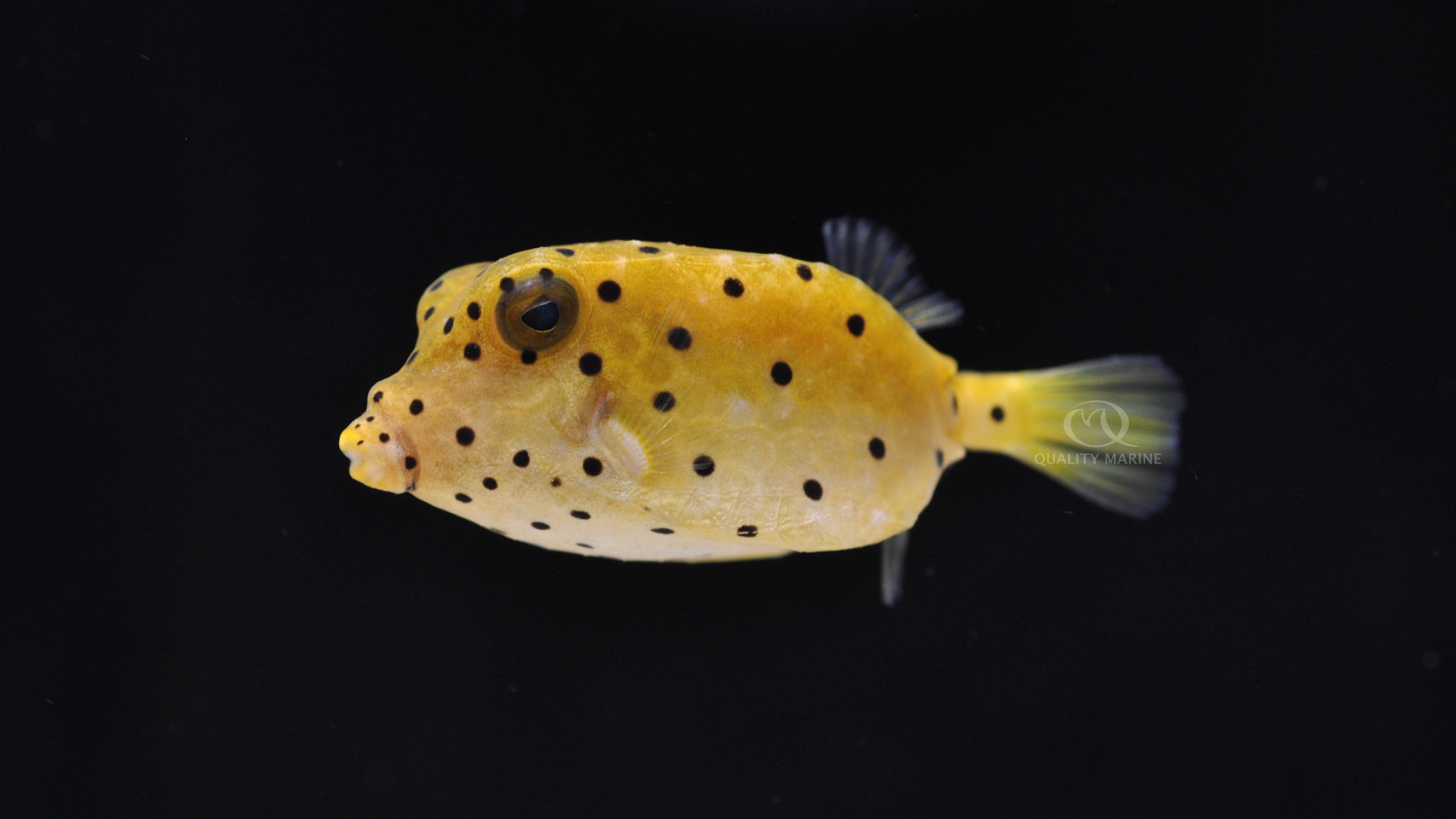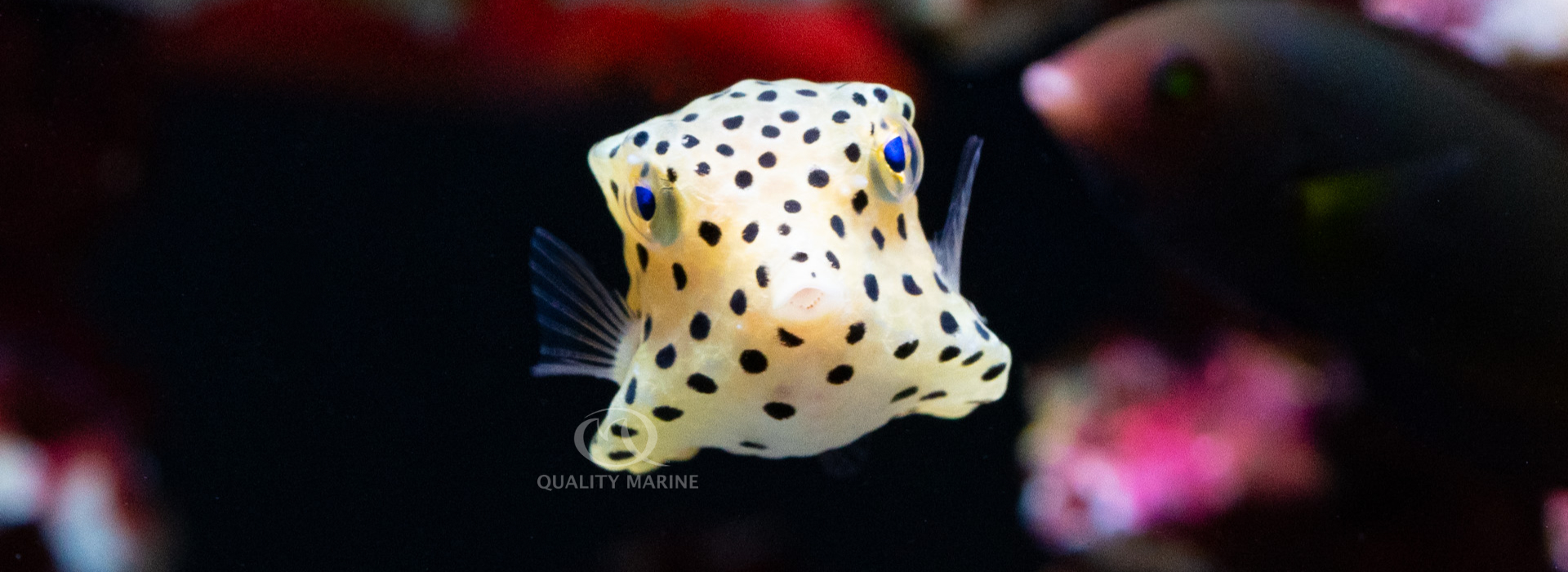The Wet Pet Called Cube

The Cubicus Trunkfish (Ostracion cubicus), also known as a Yellow Boxfish is a member of the family Ostraciidae which we more commonly call “Boxfishes.” It was described to science and given its scientific name is 1758 by Carl Linnaeus, known as the father of taxonomy (the grouping and naming of species) because he was the person who first started binomial nomenclature (binomial meaning two names, genus and species names). Ostracion is in reference to the bony plates that cover its body for protection. As a juvenile this fish is bright yellow with black spots and it slowly fades over time to a darker, bluish gray color shading over a subdued yellow, retaining only a little of its juvenile coloration once it reaches maturity. Despite the awkward body shape of Trunkfish, they move quite agilely over the reef – even to the point where one company decided to use them as motivation for the design of a vehicle shape in the early 2000’s!
These fish are wide spread throughout the Indian and Pacific Oceans from the Eastern Coast of Africa and the Red Sea to the Hawaiian islands. Cubicus Trunkfish collected in the Red Sea do appear slightly different from those collected elsewhere; it was once given its own unique scientific name, Ostracion argus. However, this is not a currently accepted species. Despite these fish being more agile swimmers than one would anticipate, they do prefer protected habitats, living in lagoons to protected reefs. Younger fish seek even more shelter living in small spaces on the reef or even within large stony coral heads. The adult fish are more powerful and can cruise the reef but still wont reside in surge areas or on the seaward reef generally.
Cubicus Trunkfish get to be fairly large; the largest one on record is 18 inches long! As such, an aquarium to house them throughout their lives must be appropriately sized. A 220 gallon aquarium would be a good starting point as a minimum size for an adult Cubicus Trunkfish. As these fish are fairly active in the wild, spending their days cruising the reef searching for something to eat, a focus on footprint over volume makes sense (Meaning an aquarium that is longer and wider will be more suitable than one that is taller.) While care should be spent in designing the aquarium so that there is plenty of open swimming space, ideally there should be large enough caves for them to explore and swim through, rest and hide in. These fish are generally peaceful, but not reef safe – more on this later. They should not be combined with other boxfish as they can be incredibly aggressive to members of the same species,other species of trunkfish, and even similarly shaped fish.
Trunkfish of all sorts carry tetrodotoxin, a chemical found in boxfish and pufferfishes. This is the same toxin found in the pufferfish Fugu that is famously called “The Most Dangerous Sushi” at specialty restaurants in Japan! However, you don’t need to eat a Trunkfish to feel the effects. Stressed Trunkfish can release this toxin through their skin, and it can kill fish around them. There are reported instances of Trunkfish dying, or even just becoming stressed in an aquarium and releasing these toxins resulting in the death of everything else in the aquarium.

Trunkfish like the Cubicus are omnivores, cruising the reef for different algae, sponges, and invertebrates to eat all day, every day, the primary reason they are not suggested for reef aquariums, but also a reason why a varied diet is important for their long term health. When the fish are small, they should be fed a quality flake or pellet along with appropriately sized frozen foods such as enriched brine shrimp or mysis shrimp. Because of their natural afinity for grazing, Nutramar Shots are a perfect food for this fish. Algae can also be supplemented in the same way it is fed to tangs in aquariums on a clip or with a magnet on the glass. As these fish grow, they can be transitioned to larger foods such as shrimp, mussels or clams on the half shell and other fresh marine based meaty foods.
These fish have never been spawned in home aquaria, so individuals for sale must be harvested sustainably from the ocean. Acquiring a specimen from a reputable source is not only the ethical choice, but should also result in a fish that is less likely to be stressed and releasing toxins. In the wild these will form harems (mating groups with one male or female and several of the other). In this case, a male will watch over several females during the breeding season and when they are ready to release their eggs he will fertilize all the females in the harems eggs as they release them during a spawning display.
While watching the Cubicus Trunkfish grow and change while meeting their rigorous needs in regards to aquarium size and filtration capabilities may seem daunting, it is a rewarding project for the advanced aquarist, and the prize for this work is a a truly magnificent, intelligent interactive wet pet. Call your local fish store and ask them to source you a sustainably caught Cubicus Trunkfish from Quality Marine today!